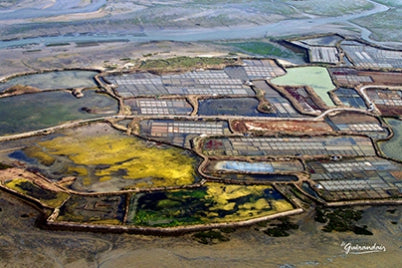
A Unique and Protected Region
The Guerande salt marshes are in Southern Brittany between the mouths of the rivers Loire and Vilaine, on the Atlantic Ocean. They form a very large wetland zone in western Loire-Atlantique region.
The surrounding areas are well known: Guérande, an artistic, historic town famous for its medieval citadel, La Baule and its famous bay, recognised as one of the loveliest in Europe, Le Croisic and Piriac, small towns of character, La Turballe, a sardine fishing port, and La Brière, mainland France’s first regional park.
Nantes, Rennes and Vannes, the prefecture towns for Loire-Atlantique, Ille et Vilaine and Le Morbihan, are less than 2 hours away by car. The TGV serves La Baule and Le Croisic, only quarter of an hour away from the salt marshes.

Salt workers don’t just produce salt: they maintain, renovate and manage a remarkable site and an extraordinary heritage. The aim is to protect this heritage from property development and to manage the number of tourists visiting the area in order to sustain a unique expertise and pass on a natural cultural heritage to future generations: the very basis of sustainable, fair development.
Long before the notion of sustainable development was highlighted by the institutions, the environment has always been a major concern to producers in the LES SALINES DE GUERANDE cooperative, as their work depends on this. A perfect balance between man and nature is essential to the production of a quality salt.
Everyone is involved in environmental preservation including not using weed killers, maintaining water networks in the unexploited parts of the salt marshes and carrying out repair works for future exploitation.
There have also been a number of actions to counter damaging development on the site: motorway bypass projects, tourist developments, filling-in of salt works, constant monitoring of water quality through physical, chemical and bacteriological analysis and, finally, the channelling of tourist flows so that tourism and salt farming can live side by side.
A large number of national and international measures have been taken to protect this heritage. The ecological value of the Guérande site is well known and protected by French and international law: the salt marshes were awarded the “paysage” label in 1992, have been on the RAMSAR list since 1995 and have been a listed site since 1996, the salt marshes' biodiversity was designated as a "protected site" by Natura 2000 in 1992.

The combined efforts of the salt workers in partnership with the nature protection associations make a daily contribution towards protecting a unique site in which the ecosystem is exceptionally rich and biodiversity is not just a word.

he Guérande salt marshes are extraordinarily full of life. The shallow water allows light to reach to bottom of the ponds, warm the clay and favour the development of plankton, which is the vital foundation of the food chain in the marshes.
This large supply of food, combined with a mild climate, makes the Guérande site a favourite over-wintering and reproduction site for birds, (bluethroats, spoonbills, godwits, terns, marsh harriers, black-winged stilts, elegant avocets, stints, barnacle geese,...). Over 280 species of migrating birds follow each other to find refuge here every year.

Statice, fennel, sea purslane… The plant life is hugely varied and colourful on the banks surrounding the ponds, including that strangest and best-known of the halophytic plants: glasswort, which grows in the salty mud for the pleasure of gourmets.
The glasswort
This plant grows in the salt water of the marshes and is well known for its diuretic and gastronomic qualities.
The young shoots can be prepared in vinegar, like gherkins, or eaten cooked like green beans.

